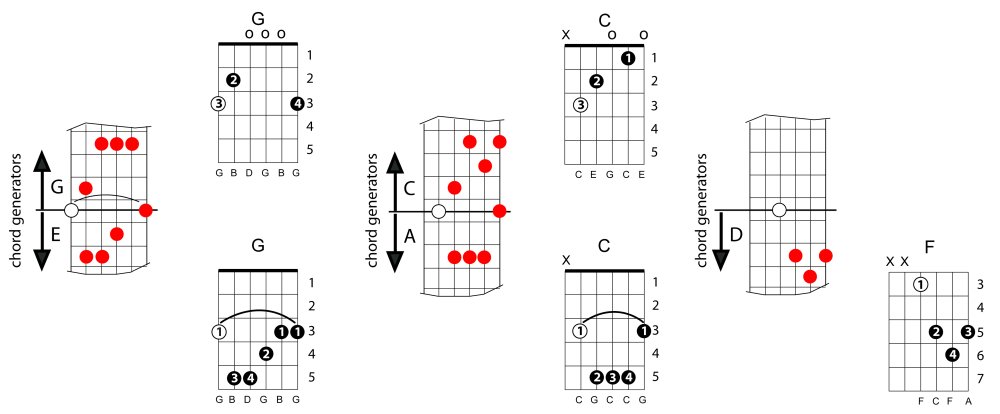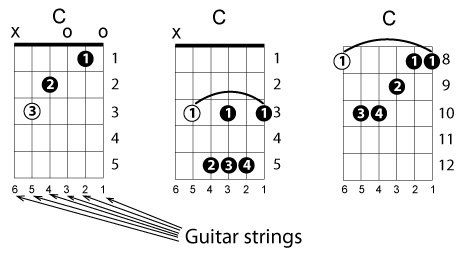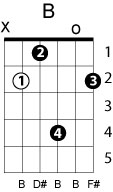About
Our goal is to help guitarist play more and better music. You will find a complete resource on chords:
tutorials, chord diagrams, generator chords, the nature of chords and how to construct them.
At all times you can copy a chord diagram and paste it into a Word document. Simply position the
cursor on the diagram, right click to see a context menu and click on "Copy" if you are in Explorer.
Then paste the image in a Word document or any other Windows compatible software program.
We will discuss scales, major scales and minor scales, why? Because musical compositions are
written in a scale and a scale allows only for certain notes and chords. When you have identified the scale you will
know which chords will likely be played.
All the chords start with the root which is indicated with a clear circle in Figure 2.
The CAGED method is used. This is the idea that the C, A, G. E and D chords played in their traditional form at
the top of the neck are basic forms or generators that can be used anywhere to generate 12 or more chords.
This provides a great simplification since you can generate many chords knowing only a few basic ones.
Each chord diagram is labeled with its proper CAGED form.

Figure 1. Using CAGED generators.
Generators have either 4th, 5th or 6th string root, there are no
generators of 3rd string or less. You will find more information about the CAGEDF method in the tutorial.
How is the information we provide different from a chord book?
Clearly identify the root of the chord
The root of the chord is identified with a clear circle. For example all C chords
will be shown with the root, the note C, as either on the 6th, 5th or 4th string so that it can be played
first. Here is an example of three C major chords.

Figure 2. Typical chord diagrams and guitar string positions.
More chords are available
All major chords are available: C, C#, D, E♭, F, F#, G, A♭, A, B♭ (C♭, D♭, D#, E#, G♭, G#, A#, B#) and their variations (44).
You may say C# and D♭ are the same chords, that's true but sometimes you will have the chord presented in its
flat mode to match the scale being used.
A web site is not limited to a certain number of pages or physical size as in the case of a book.
Therefore we can present a large variation of chord positions. However, we avoid giving parts of chords and try to make the
chords as complete as possible using as many strings as possible. The chords that we show also always start with
the root. Chord dictionaries often show chords that start with other notes then the root.
It is not that these chords are not valid but they should be labeled differently. For example a B chord
should start on a B as in this chord diagram.

If you play the B chord like this, hitting the 6th string first

you get a valid chord (all the notes belong to that chord) and a great sound but it should be labeled F#/B (F# over B).
If you start 2 Explorer browsers and compare Cmaj and C#maj for example you will see a net progression of the chords
as they move up the neck. You won't be surprised by chords in C#maj that are not shown in Cmaj unless they are chords with open strings. I
think you will find this refreshing and a great help in de-mystifying and simplifying chords with all their variations and positions on the neck.
Search for chords in different scales and positions
You have the ability to find your chords for a given scale all within a certain range of frets, making it easier to
play in a different voicing or key www.chordsandguitar.com/findchord-scales.php.
Revenues or how do they get paid for this?
It's a great pleasure to share knowledge on guitar chords, simplify what appears to be a complex subject and
help people (including us) play better music. There is no better way to get to understand something than
by having to explain it.
What financial rewards do we get out of this? At the present, none! We hope that as the site reaches more
people and traffic increases that we will be able to sell add space, hence the large white spaces you see.
So if you want to help us get better, use us. Tell your friends and help us grow.
If you would like to place an add on our site you can contact me:
Jacques Chaurette
